spare tire KIA Sportage 2012 SL / 3.G Owner's Manual
[x] Cancel search | Manufacturer: KIA, Model Year: 2012, Model line: Sportage, Model: KIA Sportage 2012 SL / 3.GPages: 387, PDF Size: 8.44 MB
Page 6 of 387
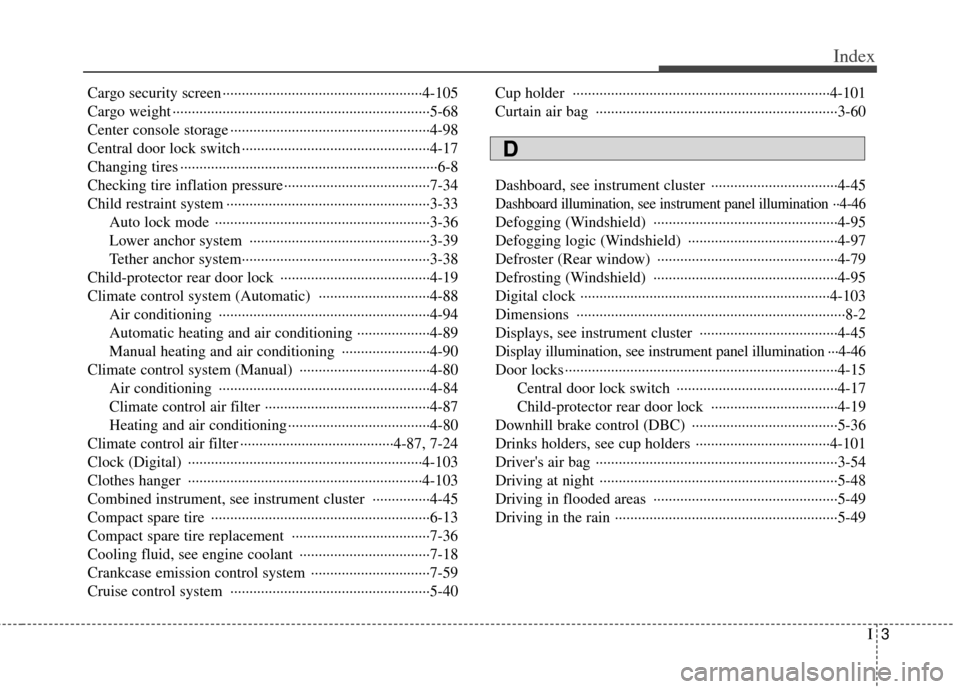
I3
Index
Cargo security screen ··················\
··················\
················4-105
Cargo weight ··················\
··················\
··················\
·············5-68
Center console storage ··················\
··················\
················4-98
Central door lock switch ··················\
··················\
·············4-17
Changing tires ··················\
··················\
··················\
·············6-8
Checking tire inflation pressure ··················\
··················\
··7-34
Child restraint system ··················\
··················\
·················3-33\
Auto lock mode ··················\
··················\
··················\
··3-36
Lower anchor system ··················\
··················\
···········3-39
Tether anchor system··················\
··················\
·············3-38
Child-protector rear door lock ··················\
··················\
···4-19
Climate control system (Automatic) ··················\
···········4-88 Air conditioning ··················\
··················\
··················\
·4-94
Automatic heating and air conditioning ·········\
··········4-89
Manual heating and air conditioning ··················\
·····4-90
Climate control system (Manual) ··················\
················4-80 Air conditioning ··················\
··················\
··················\
·4-84
Climate control air filter ··················\
··················\
·······4-87
Heating and air conditioning ··················\
··················\
·4-80
Climate control air filter ··················\
··················\
····4-87, 7-24
Clock (Digital) ··················\
··················\
··················\
·······4-103
Clothes hanger ··················\
··················\
··················\
·······4-103
Combined instrument, see instrument cluster ···············4-45
Compact spare tire ··················\
··················\
··················\
···6-13
Compact spare tire replacement ··················\
··················\
7-36
Cooling fluid, see engine coolant ··················\
················7-18
Crankcase emission control system ··················\
·············7-59
Cruise control system ··················\
··················\
················5-40 Cup holder ··················\
··················\
··················\
·············4-101
Curtain air bag ··················\
··················\
··················\
·········3-60
Dashboard, see instrument cluster ··················\
···············4-45
Dashboard illumination, see instrument panel illumination ··4-46
Defogging (Windshield) ··················\
··················\
············4-95
Defogging logic (Windshield) ··················\
··················\
···4-97
Defroster (Rear window) ··················\
··················\
···········4-79
Defrosting (Windshield) ··················\
··················\
············4-95
Digital clock ··················\
··················\
··················\
···········4-103
Dimensions ················\
··················\
··················\
··················\
8-2
Displays, see instrument cluster ··················\
··················\
4-45
Display illumination, see instrument panel illumination ···4-46
Door locks ··················\
··················\
··················\
·················4-15\
Central door lock switch ··················\
··················\
······4-17
Child-protector rear door lock ··················\
···············4-19
Downhill brake control (DBC) ··················\
··················\
··5-36
Drinks holders, see cup holders ··················\
·················4-10\
1
Driver's air bag ··················\
··················\
··················\
·········3-54
Driving at night ··················\
··················\
··················\
········5-48
Driving in flooded areas ··················\
··················\
············5-49
Driving in the rain ··················\
··················\
··················\
····5-49
D
Page 7 of 387
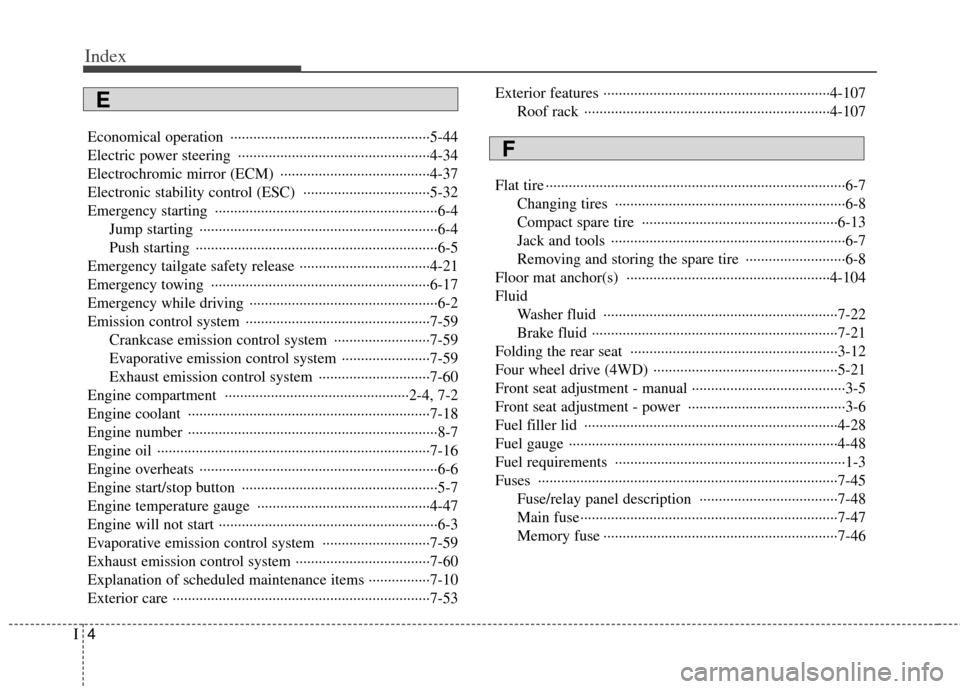
Index
4I
Economical operation ··················\
··················\
················5-44
Electric power steering ··················\
··················\
··············4-34
Electrochromic mirror (ECM) ··················\
··················\
···4-37
Electronic stability control (ESC) ··················\
···············5-32
Emergency starting ··················\
··················\
··················\
····6-4Jump starting ··················\
··················\
··················\
········6-4
Push starting ··················\
··················\
··················\
·········6-5
Emergency tailgate safety release ··················\
················4-21
Emergency towing ··················\
··················\
··················\
···6-17
Emergency while driving ··················\
··················\
·············6-2
Emission control system ··················\
··················\
············7-59 Crankcase emission control system ··················\
·······7-59
Evaporative emission control system ··················\
·····7-59
Exhaust emission control system ··················\
···········7-60
Engine compartment ··················\
··················\
············2-4, 7-2
Engine coolant ··················\
··················\
··················\
·········7-18
Engine number ··················\
··················\
··················\
···········8-7
Engine oil ··················\
··················\
··················\
·················7-16\
Engine overheats ··················\
··················\
··················\
········6-6
Engine start/stop button ··················\
··················\
···············5-7
Engine temperature gauge ··················\
··················\
·········4-47
Engine will not start ··················\
··················\
··················\
···6-3
Evaporative emission control system ··················\
··········7-59
Exhaust emission control system ··················\
·················7-60\
Explanation of scheduled maintenance items ········\
········7-10
Exterior care ··················\
··················\
··················\
·············7-53 Exterior features ··················\
··················\
··················\
·····4-107
Roof rack ··················\
··················\
··················\
··········4-107
Flat tire ··················\
··················\
··················\
··················\
······6-7 Changing tires ··················\
··················\
··················\
······6-8
Compact spare tire ··················\
··················\
···············6-13
Jack and tools ··················\
··················\
··················\
·······6-7
Removing and storing the spare tire ··················\
········6-8
Floor mat anchor(s) ··················\
··················\
·················4-10\
4
Fluid Washer fluid ··················\
··················\
··················\
·······7-22
Brake fluid ··················\
··················\
··················\
··········7-21
Folding the rear seat ··················\
··················\
··················\
3-12
Four wheel drive (4WD) ··················\
··················\
············5-21
Front seat adjustment - manual ···········\
··················\
···········3-5
Front seat adjustment - power ··················\
··················\
·····3-6
Fuel filler lid ··················\
··················\
··················\
············4-28
Fuel gauge ··················\
··················\
··················\
················4-48
Fuel requirements ··················\
··················\
··················\
······1-3
Fuses ·················\
··················\
··················\
··················\
·······7-45 Fuse/relay panel description ··················\
··················\
7-48
Main fuse··················\
··················\
··················\
·············7-47
Memory fuse ··················\
··················\
··················\
·······7-46
E
F
Page 11 of 387
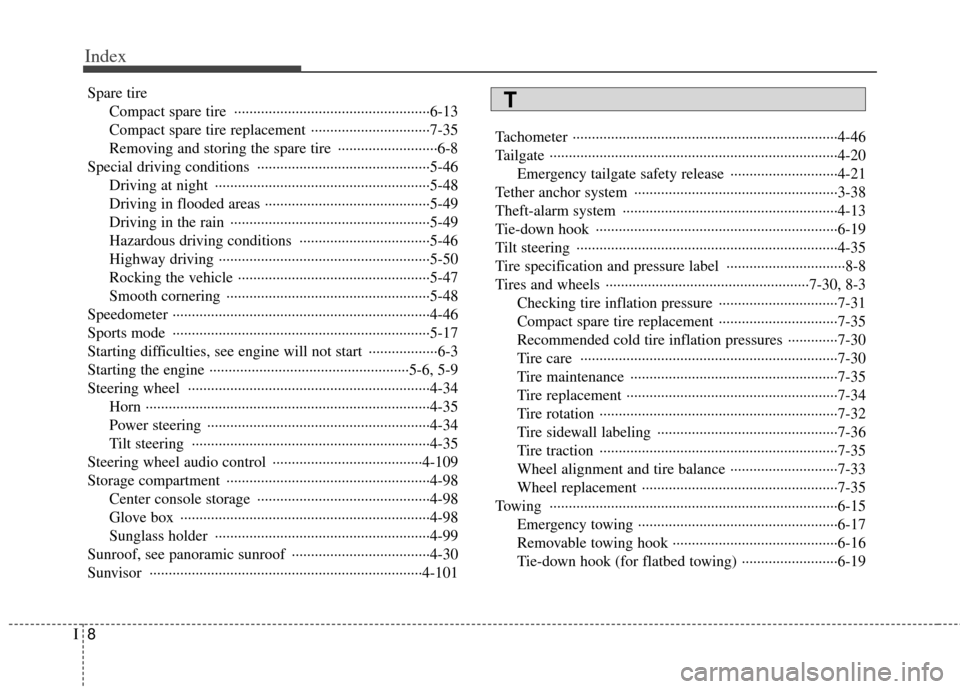
Index
8I
Spare tireCompact spare tire ··················\
··················\
···············6-13
Compact spare tire replacement ··················\
·············7-35
Removing and storing the spare tire ··················\
········6-8
Special driving conditions ··················\
··················\
·········5-46 Driving at night ··················\
··················\
··················\
··5-48
Driving in flooded areas ··················\
··················\
·······5-49
Driving in the rain ··················\
··················\
················5-49
Hazardous driving conditions ··················\
················5-46
Highway driving ··················\
··················\
··················\
·5-50
Rocking the vehicle ··················\
··················\
··············5-47
Smooth cornering ··················\
··················\
·················5-48\
Speedometer ···············\
··················\
··················\
················4-46
Sports mode ··················\
··················\
··················\
·············5-17
Starting difficulties, see engine will not start ··················\
6-3
Starting the engine ··················\
··················\
················5-6, 5-9
Steering wheel ··················\
··················\
··················\
·········4-34 Horn ·················\
··················\
··················\
··················\
···4-35
Power steering ··················\
··················\
··················\
····4-34
Tilt steering ··················\
··················\
··················\
········4-35
Steering wheel audio control ··················\
··················\
···4-109
Storage compartment ··················\
··················\
·················4-98\
Center console storage ··················\
··················\
·········4-98
Glove box ··················\
··················\
··················\
···········4-98
Sunglass holder ··················\
··················\
··················\
··4-99
Sunroof, see panoramic sunroof ··················\
··················\
4-30
Sunvisor ·················\
··················\
··················\
··················\
4-101 Tachometer ················\
··················\
··················\
·················4-46\
Tailgate ················\
··················\
··················\
··················\
·····4-20
Emergency tailgate safety release ··················\
··········4-21
Tether anchor system ··················\
··················\
·················3-38\
Theft-alarm system ··················\
··················\
··················\
··4-13
Tie-down hook ··················\
··················\
··················\
·········6-19
Tilt steering ··················\
··················\
··················\
··············4-35
Tire specification and pressure label ··················\
·············8-8
Tires and wheels ··················\
··················\
·················7-30\
, 8-3 Checking tire inflation pressure ··················\
·············7-31
Compact spare tire replacement ··················\
·············7-35
Recommended cold tire inflation pressures ·············7-30
Tire care ··················\
··················\
··················\
·············7-30
Tire maintenance ··················\
··················\
··················\
7-35
Tire replacement ··················\
··················\
··················\
·7-34
Tire rotation ··················\
··················\
··················\
········7-32
Tire sidewall labeling ··················\
··················\
···········7-36
Tire traction ··················\
··················\
··················\
········7-35
Wheel alignment and tire balance ··················\
··········7-33
Wheel replacement ··················\
··················\
···············7-35
Towing ·················\
··················\
··················\
··················\
····6-15 Emergency towing ··················\
··················\
················6-17
Removable towing hook ················\
··················\
·········6-16
Tie-down hook (for flatbed towing) ··················\
·······6-19T
Page 307 of 387
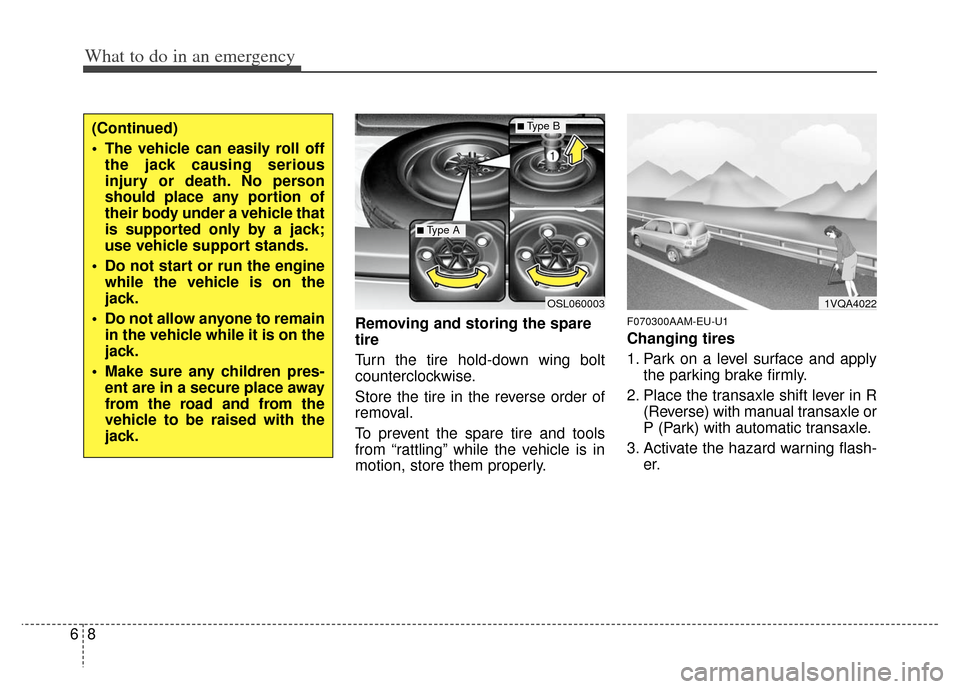
What to do in an emergency
86
Removing and storing the spare
tire
Turn the tire hold-down wing bolt
counterclockwise.
Store the tire in the reverse order of
removal.
To prevent the spare tire and tools
from “rattling” while the vehicle is in
motion, store them properly.F070300AAM-EU-U1
Changing tires
1. Park on a level surface and applythe parking brake firmly.
2. Place the transaxle shift lever in R (Reverse) with manual transaxle or
P (Park) with automatic transaxle.
3. Activate the hazard warning flash- er.
(Continued)
The vehicle can easily roll offthe jack causing serious
injury or death. No person
should place any portion of
their body under a vehicle that
is supported only by a jack;
use vehicle support stands.
Do not start or run the engine while the vehicle is on the
jack.
Do not allow anyone to remain in the vehicle while it is on the
jack.
Make sure any children pres- ent are in a secure place away
from the road and from the
vehicle to be raised with the
jack.
1VQA4022OSL060003
■Type A
■Type B
Page 308 of 387
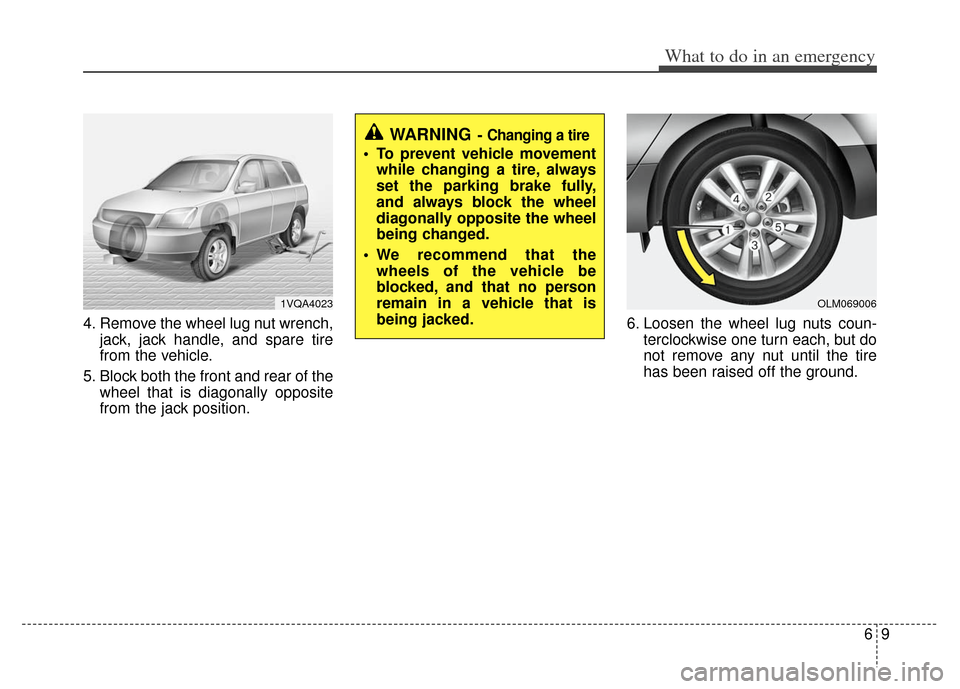
69
What to do in an emergency
4. Remove the wheel lug nut wrench,jack, jack handle, and spare tire
from the vehicle.
5. Block both the front and rear of the wheel that is diagonally opposite
from the jack position. 6. Loosen the wheel lug nuts coun-
terclockwise one turn each, but do
not remove any nut until the tire
has been raised off the ground.
WARNING- Changing a tire
To prevent vehicle movementwhile changing a tire, always
set the parking brake fully,
and always block the wheel
diagonally opposite the wheel
being changed.
We recommend that the wheels of the vehicle be
blocked, and that no person
remain in a vehicle that is
being jacked.
1VQA4023OLM069006
Page 309 of 387
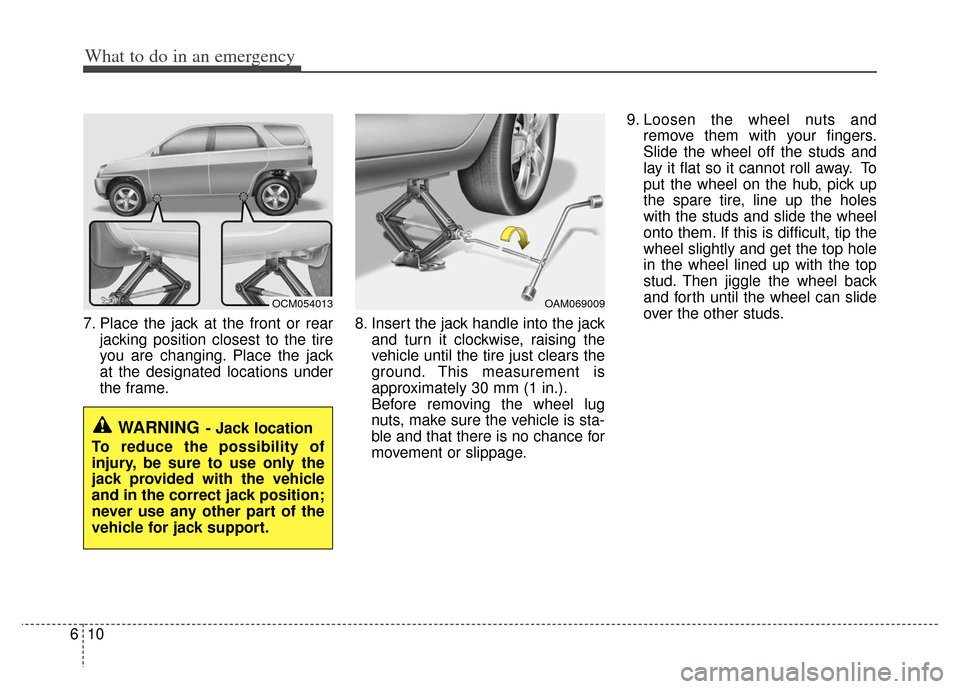
What to do in an emergency
10
6
7. Place the jack at the front or rear
jacking position closest to the tire
you are changing. Place the jack
at the designated locations under
the frame. 8. Insert the jack handle into the jack
and turn it clockwise, raising the
vehicle until the tire just clears the
ground. This measurement is
approximately 30 mm (1 in.).
Before removing the wheel lug
nuts, make sure the vehicle is sta-
ble and that there is no chance for
movement or slippage. 9. Loosen the wheel nuts and
remove them with your fingers.
Slide the wheel off the studs and
lay it flat so it cannot roll away. To
put the wheel on the hub, pick up
the spare tire, line up the holes
with the studs and slide the wheel
onto them. If this is difficult, tip the
wheel slightly and get the top hole
in the wheel lined up with the top
stud. Then jiggle the wheel back
and forth until the wheel can slide
over the other studs.
WARNING- Jack location
To reduce the possibility of
injury, be sure to use only the
jack provided with the vehicle
and in the correct jack position;
never use any other part of the
vehicle for jack support.
OCM054013OAM069009
Page 311 of 387
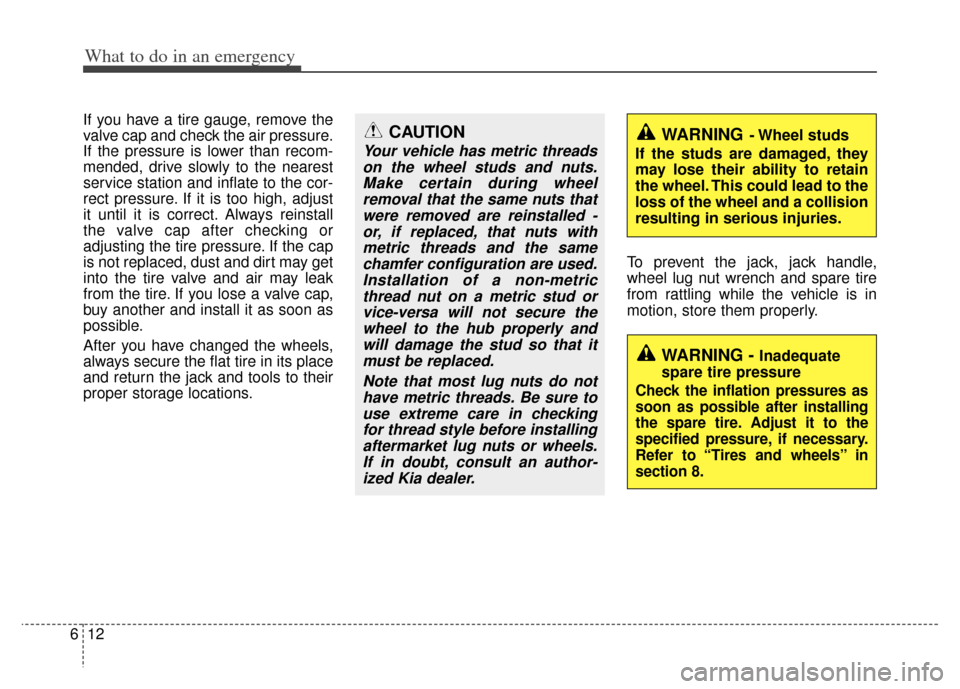
What to do in an emergency
12
6
If you have a tire gauge, remove the
valve cap and check the air pressure.
If the pressure is lower than recom-
mended, drive slowly to the nearest
service station and inflate to the cor-
rect pressure. If it is too high, adjust
it until it is correct. Always reinstall
the valve cap after checking or
adjusting the tire pressure. If the cap
is not replaced, dust and dirt may get
into the tire valve and air may leak
from the tire. If you lose a valve cap,
buy another and install it as soon as
possible.
After you have changed the wheels,
always secure the flat tire in its place
and return the jack and tools to their
proper storage locations. To prevent the jack, jack handle,
wheel lug nut wrench and spare tire
from rattling while the vehicle is in
motion, store them properly.CAUTION
Your vehicle has metric threads
on the wheel studs and nuts.Make certain during wheelremoval that the same nuts thatwere removed are reinstalled -or, if replaced, that nuts withmetric threads and the samechamfer configuration are used.Installation of a non-metricthread nut on a metric stud orvice-versa will not secure thewheel to the hub properly andwill damage the stud so that itmust be replaced.
Note that most lug nuts do nothave metric threads. Be sure touse extreme care in checkingfor thread style before installingaftermarket lug nuts or wheels.If in doubt, consult an author-ized Kia dealer.
WARNING- Wheel studs
If the studs are damaged, they
may lose their ability to retain
the wheel. This could lead to the
loss of the wheel and a collision
resulting in serious injuries.
WARNING - Inadequate
spare tire pressure
Check the inflation pressures as
soon as possible after installing
the spare tire. Adjust it to the
specified pressure, if necessary.
Refer to “Tires and wheels” in
section 8.
Page 312 of 387
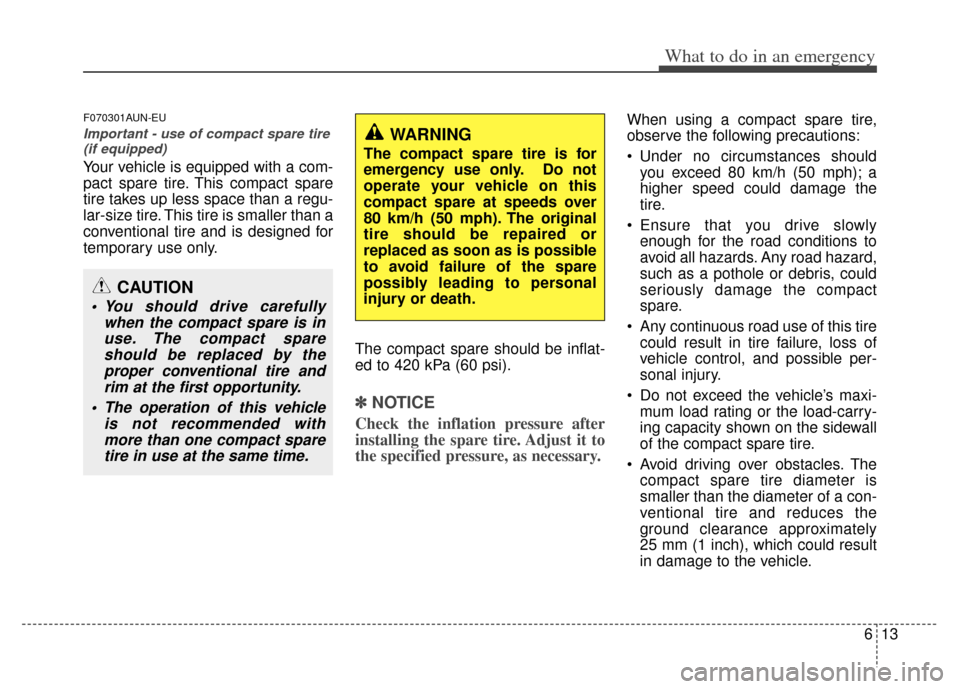
613
What to do in an emergency
F070301AUN-EU
Important - use of compact spare tire(if equipped)
Your vehicle is equipped with a com-
pact spare tire. This compact spare
tire takes up less space than a regu-
lar-size tire. This tire is smaller than a
conventional tire and is designed for
temporary use only.
The compact spare should be inflat-
ed to 420 kPa (60 psi).
✽ ✽NOTICE
Check the inflation pressure after
installing the spare tire. Adjust it to
the specified pressure, as necessary.
When using a compact spare tire,
observe the following precautions:
Under no circumstances should
you exceed 80 km/h (50 mph); a
higher speed could damage the
tire.
Ensure that you drive slowly enough for the road conditions to
avoid all hazards. Any road hazard,
such as a pothole or debris, could
seriously damage the compact
spare.
Any continuous road use of this tire could result in tire failure, loss of
vehicle control, and possible per-
sonal injury.
Do not exceed the vehicle’s maxi- mum load rating or the load-carry-
ing capacity shown on the sidewall
of the compact spare tire.
Avoid driving over obstacles. The compact spare tire diameter is
smaller than the diameter of a con-
ventional tire and reduces the
ground clearance approximately
25 mm (1 inch), which could result
in damage to the vehicle.
CAUTION
You should drive carefully when the compact spare is inuse. The compact spareshould be replaced by theproper conventional tire andrim at the first opportunity.
The operation of this vehicle is not recommended withmore than one compact sparetire in use at the same time.
WARNING
The compact spare tire is for
emergency use only. Do not
operate your vehicle on this
compact spare at speeds over
80 km/h (50 mph). The original
tire should be repaired or
replaced as soon as is possible
to avoid failure of the spare
possibly leading to personal
injury or death.
Page 313 of 387
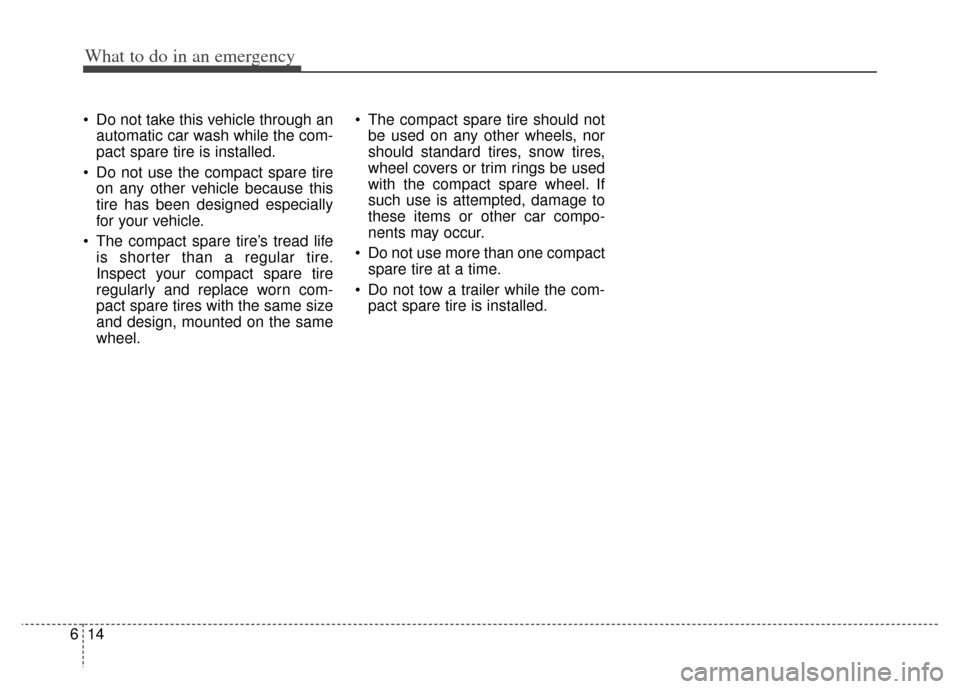
What to do in an emergency
14
6
Do not take this vehicle through an
automatic car wash while the com-
pact spare tire is installed.
Do not use the compact spare tire on any other vehicle because this
tire has been designed especially
for your vehicle.
The compact spare tire’s tread life is shorter than a regular tire.
Inspect your compact spare tire
regularly and replace worn com-
pact spare tires with the same size
and design, mounted on the same
wheel. The compact spare tire should not
be used on any other wheels, nor
should standard tires, snow tires,
wheel covers or trim rings be used
with the compact spare wheel. If
such use is attempted, damage to
these items or other car compo-
nents may occur.
Do not use more than one compact spare tire at a time.
Do not tow a trailer while the com- pact spare tire is installed.
Page 323 of 387
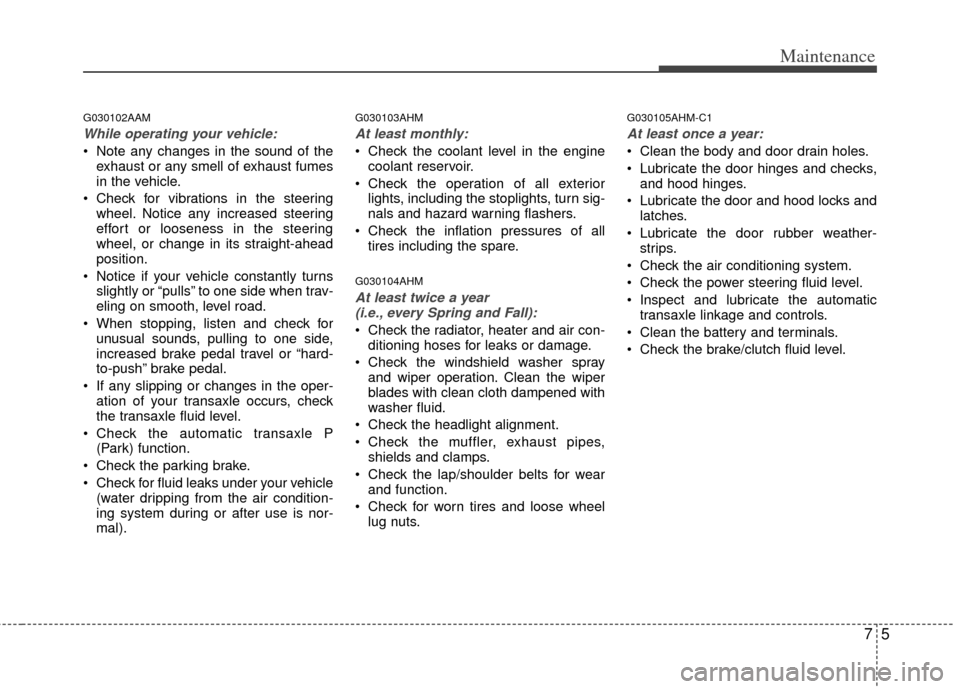
75
Maintenance
G030102AAM
While operating your vehicle:
Note any changes in the sound of theexhaust or any smell of exhaust fumes
in the vehicle.
Check for vibrations in the steering wheel. Notice any increased steering
effort or looseness in the steering
wheel, or change in its straight-ahead
position.
Notice if your vehicle constantly turns slightly or “pulls” to one side when trav-
eling on smooth, level road.
When stopping, listen and check for unusual sounds, pulling to one side,
increased brake pedal travel or “hard-
to-push” brake pedal.
If any slipping or changes in the oper- ation of your transaxle occurs, check
the transaxle fluid level.
Check the automatic transaxle P (Park) function.
Check the parking brake.
Check for fluid leaks under your vehicle (water dripping from the air condition-
ing system during or after use is nor-
mal).
G030103AHM
At least monthly:
Check the coolant level in the enginecoolant reservoir.
Check the operation of all exterior lights, including the stoplights, turn sig-
nals and hazard warning flashers.
Check the inflation pressures of all tires including the spare.
G030104AHM
At least twice a year (i.e., every Spring and Fall):
Check the radiator, heater and air con- ditioning hoses for leaks or damage.
Check the windshield washer spray and wiper operation. Clean the wiper
blades with clean cloth dampened with
washer fluid.
Check the headlight alignment.
Check the muffler, exhaust pipes, shields and clamps.
Check the lap/shoulder belts for wear and function.
Check for worn tires and loose wheel lug nuts.
G030105AHM-C1
At least once a year:
Clean the body and door drain holes.
Lubricate the door hinges and checks,and hood hinges.
Lubricate the door and hood locks and latches.
Lubricate the door rubber weather- strips.
Check the air conditioning system.
Check the power steering fluid level.
Inspect and lubricate the automatic transaxle linkage and controls.
Clean the battery and terminals.
Check the brake/clutch fluid level.